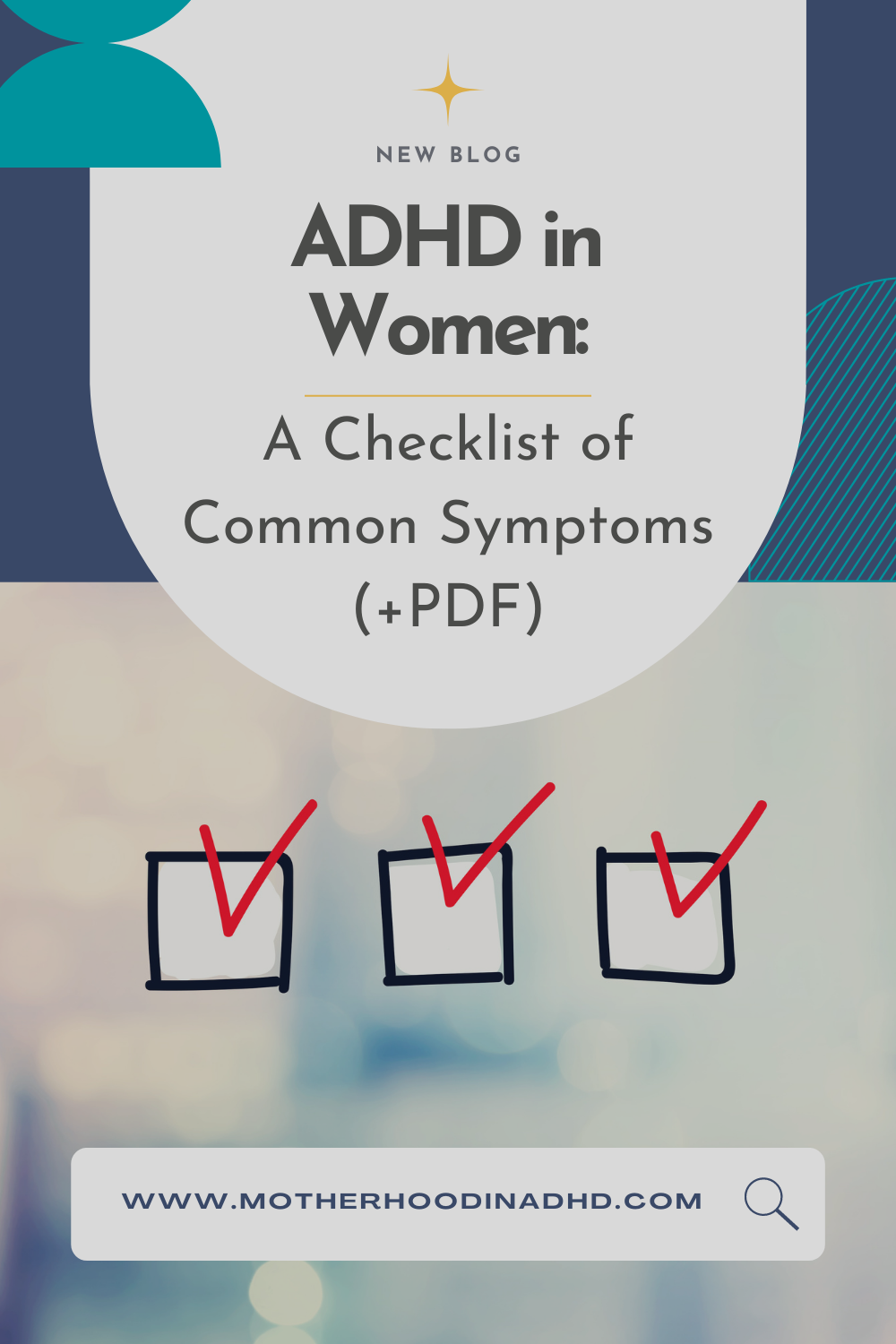ADHD in Women: A Checklist of Common Symptoms (+PDF)
Disclaimer: The following article is research-based, and is not intended to be medical advice. Only a licensed healthcare provider can diagnose ADHD – so if you suspect you may have it, please consult with your physician.
What does ADHD in women look like?
The answer may surprise you.
ADHD is typically associated with hyperactivity and impulsiveness – picture your typical school-aged boy, fidgeting in class and talking out of turn.
But what about the little girl sitting in the back of the class, daydreaming?
The girl that feels restless and bored but hides it so well the teacher doesn’t notice? Or she’s dozing off in class and labeled “lazy”?
ADHD is underdiagnosed in women – because our symptoms often present differently than they do in men and boys.
In Episode #140 of the Motherhood in ADHD podcast, Dr. Sasha Hamdani talks about how she was that little girl, and gives us details on how ADHD shows up in women.
Listen to Dr. Sasha Hamdani’s interview on the podcast here:
Here we’ll dive more deeply into how specific symptoms may appear in daily life and provide a handy, downloadable checklist of symptoms of ADHD in women.
We’ll also give you a few tips on how to find the right doctor for your ADHD diagnosis, and how to approach the topic with your doctor.
Let’s dig in.
Is ADHD different in women?
ADHD can present differently in girls and women – with symptoms like inattention, forgetfulness and disorganization showing up more obviously than the hyperactivity and impulsiveness seen in men and boys with ADHD.
There are three types of ADHD – inattentive (inattentive symptoms are dominant), hyperactive (hyperactive and impulsive symptoms are dominant), and combined (both hyperactive and inattentive symptoms show up equally).
Because women and girls are likely to present as inattentive, their symptoms aren’t as disruptive in the classroom – so girls may enter into adulthood without receiving a diagnosis.
Gender bias is also a factor. Because symptoms like shyness and daydreaming are seen as “feminine” characteristics, teachers and parents may assume these are just personality traits.
It’s important to note that women and girls with ADHD can also be hyperactive – but rather than causing physical disruption, their symptoms may manifest as nervous fidgeting, anxious thoughts, quirky daydreaming, and chattiness – more symptoms that may be incorrectly labeled as personality traits.
ADHD in Women: A Checklist of Symptoms
Click here to download and print this ADHD in Women Checklist, to take it with you to your doctor.
If you’re a woman, how do you know you have ADHD?
The following checklist is based on research, and if you relate to some of these symptoms, you may have ADHD.
This checklist is not comprehensive – everyone’s ADHD shows up a bit differently, so you may not see all your symptoms on this list, or have all of the symptoms listed here. That’s why we’ve added some additional spaces under each symptom (in the PDF version), so you can pencil in your own examples.
Again, only a licensed physician can diagnose ADHD, so this checklist cannot serve as a diagnosis.
The following is a checklist of common symptoms of ADHD in women, along with a description of each symptom and examples of how the symptom might manifest in your life.
1. Difficulty paying attention
Difficulty sustaining attention is a hallmark symptom of all three types of ADHD.
You might struggle to pay attention during tasks or conversations that aren’t fascinating to you.
Inattention may become worse during or after stressful situations, when you feel overstimulated, or when your hormones are fluctuating (aka puberty, PMS, pregnancy, postpartum, perimenopause or menopause).
What it might look like in women:
Difficulty listening/paying attention during boring conversations, work trainings or anything else that isn’t interesting to you
Missing chunks of what a friend or colleague said to you because you stopped listening (accidentally)
Finding it hard or impossible to sustain attention during tasks you find boring or repetitive
Avoiding tasks that require sustained focus
Saying “what?” after someone asks a question, then answering before they finished repeating themselves (because your brain needed more time to catch up, but not that much time)
Difficulty paying attention during phone conversations
Sustaining minor injuries frequently – stubbing your toe or running into things (because your brain is always one step ahead, and not paying attention to where your body is in space)
2. Forgetfulness
People with ADHD suffer from executive dysfunction – meaning the part of your brain (the frontal lobe, to be specific) that handles working memory is less functional in ADHD brains than in neurotypical brains.
When you have ADHD, your thoughts may come and go rapidly, causing you to forget what you were just thinking about a moment ago.
What it might look like in women:
Frequently forgetting what you were going to say or do throughout the day
Feeling a thought slip away to be quickly replaced by another
Misplacing or losing needed items frequently – your purse, keys, wallet, phone or anything else – sometimes it seems like things just “disappear”, even though you know you were just holding them! (You just weren’t paying attention when you set it down)
Starting with one task, and becoming distracted by another – then forgetting to return to finish the original task, which can be as simple as not closing cabinet doors while cooking
Forgetting to eat lunch, forgetting to order sweet and sour sauce with your nuggets, forgetting to text people back, forgetting an important appointment (even though you may have thought about the appointment several times that day or week)
3. Time blindness
Part of the brain’s executive functioning is the accurate perception of time – what time of day or night it is, how much time has passed, or measuring how long it takes to do a task.
Because people with ADHD struggle with executive dysfunction, they also struggle to accurately perceive time.
What it might look like in women:
Constantly arriving late to work, school, events or appointments – despite your best efforts to be on time
Getting “lost” in a task, not realizing that hours have passed
Getting ready to leave when it’s already past time to leave
Failing to plan for “transition” time – parking your car, getting gas, using the bathroom before a meeting, walking to a location or driving in traffic – resulting in being late
Cramming too many tasks, events or meetings into your schedule, not realizing you don’t have time to do them all (you didn’t accurately measure how much time they’d take)
4. Trouble staying organized
Another part of healthy executive functioning is the ability to organize tasks into sequential steps, prioritize tasks according to importance, execute tasks efficiently, and develop orderly routines.
People with ADHD struggle with organizing various aspects of their lives – including their physical space and belongings, schedules and calendars, and multi-step tasks.
What it might look like in women:
The inability to keep your living space and belongings neat and organized – or you may keep your office neat (out of necessity) but your house is messy
Piles and piles of paper clutter – bills, old mail, flyers, notebooks, homework – you don’t want to throw them away (because you might need them!) but you don’t know where to put them either
You realize your life and home need structure, but structure also feels a bit oppressive and overwhelming. You might implement a routine but struggle to stay consistent with it
Trouble prioritizing tasks according to importance – you just handle what comes up during the day, rather than accomplishing planned tasks (or you don’t plan at all)
5. Hyperactivity
Hyperactivity is a hallmark symptom for people diagnosed with hyperactive-type ADHD.
Hyperactive ADHDers have trouble sitting still, are always on the move, and are often seen as having higher energy levels than peers.
What it might look like in women:
Talking excessively and rapidly – because your thoughts come and go so quickly
High levels of energy – your friends ask where you get all your energy. You may also have energy spikes and crashes (periods of low energy after a spike)...remember how that last rage cleaning session took you down?
Inability to sit still – activities, like sitting and listening to a lecture or watching a movie are uncomfortable if they’re not about a fascinating topic
Always on the go – you attack the day with ferocity – doing one task after another, then crashing at night
Racing thoughts – one thought follows another rapidly, making it difficult to express yourself sometimes or fall asleep at night
Fidgeting, leg bouncing, biting fingernails, hair twirling, or pulling out hair (also known as Trichotillomania)
6. Impulsivity
Another part of the brain’s executive function is the ability to think and consider the consequences of an action before doing it.
This ability can be weaker in people with ADHD – which means they may end up acting on impulse more than their neurotypical peers.
What it might look like in women:
Thinking out loud – blurting out your thoughts without considering how people might receive them
Interrupting during conversations
Excessive spending and impulse buying, even though you have a budget
Quitting your job without a backup plan
Frequently jumping from one hobby to the next after buying aaaaaaall the supplies
Picking fights or causing drama (for the stimulation it brings)
Binge eating junk food late at night after following your meal plan all day
Texting your ex even though you vowed you’d never speak to them again
7. Feeling easily overwhelmed
People with ADHD feel easily overwhelmed because they know they struggle to stay focused and organized.
When a person with ADHD is overloaded with tasks, they freeze or shut down because they don’t know where to start, and worry they might fail (due to their ADHD symptoms getting in the way).
What it might look like in women:
Freezing or shutting down when given too many tasks to do at once, or being asked to do a task in a noisy, distracting environment
Inability to make a decision when given too many choices – like when a menu has too many options
Needing to take frequent breaks from intense, highly-focused work
Medusa Mom at bedtime: Losing your -beep- on your kids because you have zero patience left this late in the day
8. Hypersensitivity
People with ADHD are often highly sensitive – to surrounding stimuli, their own emotions, and the emotions of others.
Rejection sensitivity (or Rejection Sensitive Dysphoria) is a disorder commonly associated with ADHD.
What it might look like in women:
Feeling overstimulated at the end of the day, or feeling “touched out” by your children or spouse and needing physical space
Feeling overwhelmed and bothered by strong smells, bright lights or loud noises, itchy or uncomfortable clothing
Rejection sensitivity – rejection or criticism feels like a knife through the heart – you have an unusually strong, almost physical, reaction to it
Picky eating – you’re bothered by the textures, smells or tastes of certain foods
Pain sensitivity
Concerts, sports arenas or loud children may be too much for your ears
9. Hyper-focusing
It may seem like an oxymoron to say that ADHDers can hyperfocus on tasks, but they can – as long as they’re stimulating enough.
However, people with ADHD may hyperfocus on a task to the point of obsession, while neglecting other important tasks.
What it might look like in women:
Getting “lost” in a fun project, not realizing several hours have passed
Obsessing over a hobby while neglecting responsibilities or other important tasks
Going down Google “rabbit holes” and learning everything about a topic when you should have been making dinner
Overthinking or “analysis paralysis” when researching a topic or trying to make a decision
Ruminating (mentally obsessing) for hours (or days) about personal mistakes or rude comments from others
Intrusive thoughts that have you rocketing down the “what if” trail and you just can’t let go
10. Easily distracted
People with ADHD are easily distracted – by their own thoughts or by outside stimuli.
This symptom contributes to their difficulty paying attention and forgetfulness.
What it might look like in women:
Being insatiably curious and going down Google “rabbit holes” and allowing each piece of new information to lead to another topic – before you know it, hours have passed - even if you’re supposed to be working or taking care of responsibilities
Feeling the irresistible urge to instantly check all notifications on your phone – email, social media, texts, etc – and then forgetting about the task you were doing
You unintentionally stop listening to a conversation because you were distracted by your own (more interesting or urgent) thoughts
Trouble staying mentally present when hanging out with friends, during conversations, or during sex with your partner
11. Impatience
Because ADHDers are always on the go, have so much energy and struggle with impulsivity, they are also naturally impatient.
Impatience can also come from the inability to sustain attention – they want to get to the point as quickly as possible so they can move on to the next thing.
What it might look like in women:
Interrupting frequently during conversations
Jumping in the shorter checkout line in the grocery store
Gets frustrated with long-winded stories – you want people to get to the point
You feel frustrated when others cannot “read your mind” and give you exactly what you want or need
Losing motivation when a goal isn’t achieved quickly
You want to be immediately good at everything – you resent having to work hard over the long term and having to struggle at first
12. Emotional dysregulation
Adults and children with ADHD are highly sensitive – they’re easily overcome by strong emotions.
Combine an emotional sensitivity with impatience and impulsivity, and emotional meltdowns or fits of rage can occur.
What it might look like in women:
Feeling anger or intense rage when frustrated, lashing out angrily in the moment – regretting it later
Trouble regulating emotions when overtired – lashing out and snapping at friends or family
Exaggerated mood swings during menstrual cycle
Melting down, immediately crying or shutting down when overwhelmed with emotion
Losing your temper at the drop of a hat or it feels like the severity of your reaction doesn’t match the intensity of the incident
How to Talk to Your Doctor About ADHD
If you find yourself relating to several (or all) of the above symptoms, it may be time for you to reach out to your doctor about an ADHD screening.
But it may seem intimidating or overwhelming to schedule an appointment.
You might think – what if they think I’m lying to get medication?
What if they judge or criticize me?
What if they don’t believe me?
These thoughts are very common – but rest assured, the right doctor will never ignore or criticize you.
When seeking an ADHD diagnosis, it’s best to find a clinician that specializes in treating ADHD – so you can be certain they understand the condition and have experience with treating people like you.
Try searching for a specialist online, calling your insurance company to see who is in-network, or paying a visit to your primary care doctor and asking for a referral.
It’s hard to remember things when you’re on the spot (especially when you have ADHD!), so it will help to print out this checklist, add your own unique symptoms to the list, and bring it with you to your appointment.
Treatment Options for ADHD in Women
Treatment options for ADHD in women include but aren’t limited to psychotherapy, stimulant, and non-stimulant medications, behavioral interventions, and learning ADHD-focused strategies.
You and your doctor can discuss the efficacy and potential side effects of each treatment, and it will be up to you to choose your best treatment option.
Some women with ADHD choose to work with ADHD coaches – people who have ADHD themselves and have learned habits and tools to make life easier. ADHD coaches often have more time to spend with you, and do not have to contend with insurance providers to offer help.
If you’re struggling to manage life with ADHD, a combination of medical treatment and coaching can help improve your symptoms and lifestyle.
As a coach for moms with ADHD, I’ve helped hundreds of women with daily planning, time management, motivation and more.
Learn more about my coaching and courses here. Download your free ADHD in Women Checklist to set yourself up to feel confident at your next doctor appointment.






